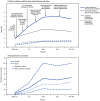Racial and Ethnic Disparities in Mpox Cases and Vaccination Among Adult Males - United States, May-December 2022
- PMID: 37053122
- PMCID: PMC10121252
- DOI: 10.15585/mmwr.mm7215a4
Racial and Ethnic Disparities in Mpox Cases and Vaccination Among Adult Males - United States, May-December 2022
Abstract
As of December 31, 2022, a total of 29,939 monkeypox (mpox) cases* had been reported in the United States, 93.3% of which occurred in adult males. During May 10-December 31, 2022, 723,112 persons in the United States received the first dose in a 2-dose mpox (JYNNEOS)† vaccination series; 89.7% of these doses were administered to males (1). The current mpox outbreak has disproportionately affected gay, bisexual, and other men who have sex with men (MSM) and racial and ethnic minority groups (1,2). To examine racial and ethnic disparities in mpox incidence and vaccination rates, rate ratios (RRs) for incidence and vaccination rates and vaccination-to-case ratios were calculated, and trends in these measures were assessed among males aged ≥18 years (males) (3). Incidence in males in all racial and ethnic minority groups except non-Hispanic Asian (Asian) males was higher than that among non-Hispanic White (White) males. At the peak of the outbreak in August 2022, incidences among non-Hispanic Black or African American (Black) and Hispanic or Latino (Hispanic) males were higher than incidence among White males (RR = 6.9 and 4.1, respectively). Overall, vaccination rates were higher among males in racial and ethnic minority groups than among White males. However, the vaccination-to-case ratio was lower among Black (8.8) and Hispanic (16.2) males than among White males (42.5) during the full analytic period, indicating that vaccination rates among Black and Hispanic males were not proportionate to the elevated incidence rates (i.e., these groups had a higher unmet vaccination need). Efforts to increase vaccination among Black and Hispanic males might have resulted in the observed relative increased rates of vaccination; however, these increases were only partially successful in reducing overall incidence disparities. Continued implementation of equity-based vaccination strategies is needed to further increase vaccination rates and reduce the incidence of mpox among all racial and ethnic groups. Recent modeling data (4) showing that, based on current vaccination coverage levels, many U.S. jurisdictions are vulnerable to resurgent mpox outbreaks, underscore the need for continued vaccination efforts, particularly among racial and ethnic minority groups.
Conflict of interest statement
All authors have completed and submitted the International Committee of Medical Journal Editors form for disclosure of potential conflicts of interest. No potential conflicts of interest were disclosed.
Figures

References
-
- CDC. Mpox: risk assessment of mpox resurgence and vaccination considerations. Atlanta, GA: US Department of Health and Human Services, CDC; 2023. https://www.cdc.gov/poxvirus/mpox/response/2022/risk-assessment-of-resur...
MeSH terms
LinkOut - more resources
Full Text Sources
Medical
Research Materials

